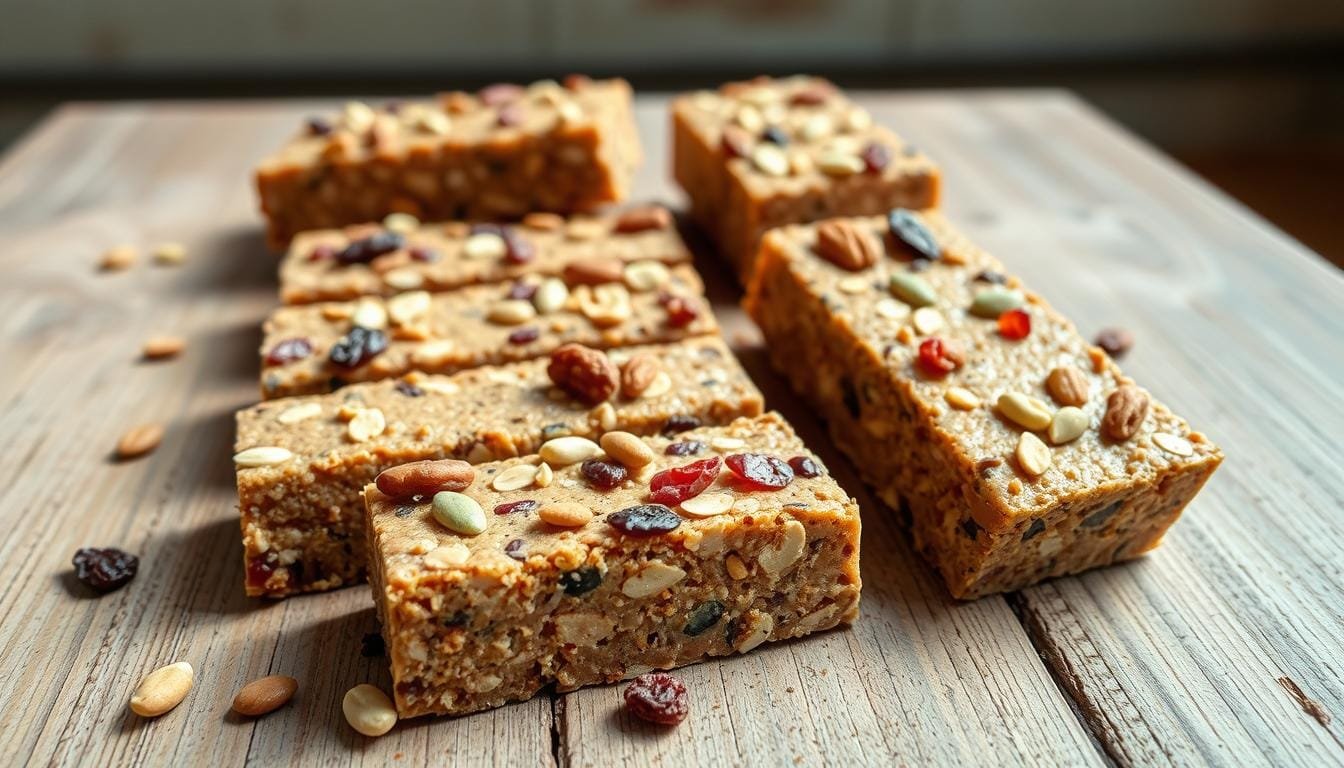I love being outdoors and always need snacks that keep me going. Plant-based energy bars are perfect for me. They’re made with simple ingredients like raisins, pecans, and pumpkin seeds. They give me long-lasting energy and 10g of protein without added sugars.
Brands like SD Bar and Näak make these bars. They’re packed with nutrients for athletes and outdoor lovers. These bars are great for fueling up before a workout, getting a boost during a hike, and recovering after.
These bars give me the energy to tackle any adventure. They have the right mix of carbs, fats, and protein. This keeps my body fueled and me satisfied all day long.
Understanding the Power of Plant-based Nutrition for Athletes
Fueling your body right is key for top performance. Plant-based nutrition is packed with benefits for athletes. These bars offer essential nutrients and natural ingredients for sustained energy.
Essential Nutrients for Athletic Performance
These energy bars have a 4:1 carb-to-protein ratio, perfect for long activities. They also have plant-based proteins and 180mg of essential electrolytes. This supports your energy and hydration during exercise.
Why Natural Ingredients Matter
These bars use wholesome ingredients like nuts, seeds, and dried fruits. They provide essential vitamins, minerals, and antioxidants without artificial additives. Natural ingredients help boost your performance and health.
The Role of Sustained Energy Release
The bars’ mix of complex carbs, fiber, and proteins gives you steady energy. This helps you power through workouts without energy drops.
“A vegan diet does not enhance performance, adaptation, or recovery in athletes, but can be followed without detriment.”
Plant-based nutrition unlocks your athletic abilities and supports a healthy lifestyle.
Plant-based Energy Bars: Your Perfect Outdoor Companion
As an outdoor lover, I know how vital good nutrition is for my adventures. That’s why I choose plant-based energy bars for hiking, camping, and more. These bars are easy to carry and give me the energy I need to keep going.
Plant-based energy bars are great for muscle recovery and gut health. They have nuts, seeds, and dried fruits that are full of vitamins and minerals. This means I can enjoy a snack without worrying about sugar crashes.
When picking a bar for my outdoor fun, I look for ones with lots of protein, fiber, and healthy fats. The ALOHA Chocolate Fudge Brownie Protein Bar has 17 grams of protein and 3 grams of fiber. It’s a favorite of mine, with a 4.8-star rating from 371 reviews.
“ALOHA’s plant-based energy bars have been a game-changer for my hiking and cycling adventures. The sustained energy release and gut-friendly ingredients keep me fueled and feeling great, even on the toughest trails.”
I also love how versatile these bars are. I can eat them on the go, before working out, or even as a topping. Their convenience makes them perfect for any outdoor activity.
In short, if you love the outdoors like me, try plant-based energy bars. They’re a great mix of nutrition, energy, and gut health for your adventures. So, remember to pack some for your next outdoor trip.
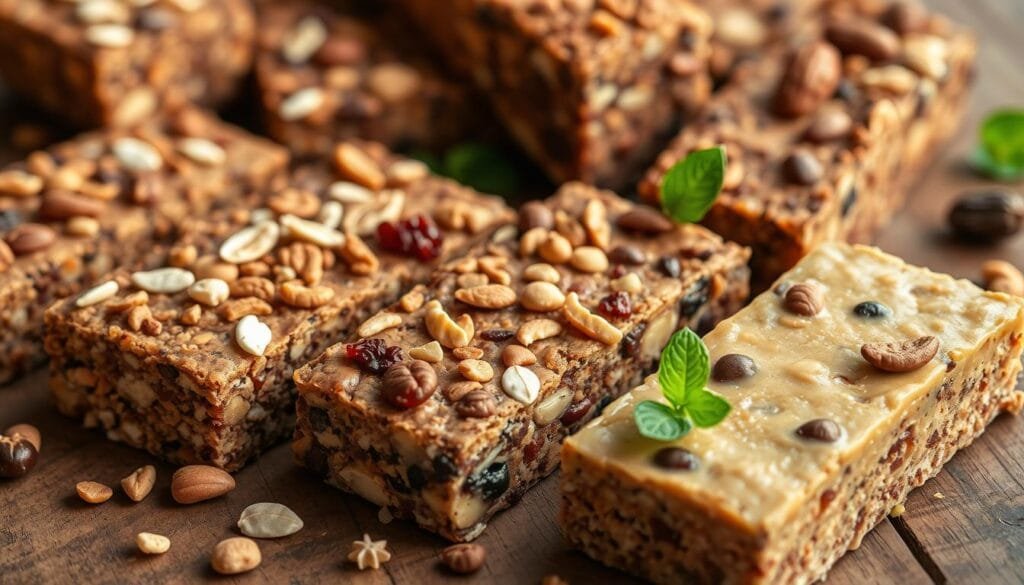
Natural Ingredients That Pack a Powerful Punch
Plant-based energy bars are key for an active lifestyle. They use natural protein sources, energy-boosting ingredients, and superfoods. The clean-eating movement has changed the energy bar world.
Nuts and Seeds: Nature’s Protein Powerhouse
ALOHA’s energy bars mix nuts and seeds for natural protein. You get almonds, pecans, pumpkin seeds, and hemp hearts. They help muscles recover and grow.
Adults need 0.36 grams of protein per pound of body weight. These natural protein sources are great for an active life.
Dried Fruits: Natural Energy Boosters
Dried fruits like raisins and golden berries are in these bars too. They give you carbs for workouts and keep energy up. They also help with digestion and gut health.
Superfoods and Their Benefits
Many bars add superfoods like dark chocolate and pink Himalayan salt. Dark chocolate has antioxidants. Pink Himalayan salt keeps electrolytes balanced and helps with hydration.
These clean eating ingredients make a balanced snack. They’re perfect for an active lifestyle.
“By choosing natural, plant-based energy bars, you’re not only nourishing your body, but also supporting sustainable, eco-friendly production practices.”
The Science Behind Sustainable Energy Release
Plant-based energy bars are fascinating for powering your active life. They offer complex carbohydrates and a balanced macronutrient ratio. This ensures slow-release energy and blood sugar stabilization. You get a steady energy boost for workouts and adventures without energy crashes.
The glycemic index is key. It shows how fast a food raises blood sugar. Plant-based bars have a 4:1 ratio of carbs to protein. This slows sugar absorption and gives energy gradually. It prevents blood sugar spikes and dips, keeping you energized and focused.
Nuts and seeds are great for slow-releasing energy. They offer complex carbs, healthy fats, and plant-based proteins. These ingredients fuel your body without overwhelming it.
| Nutrient | Vegan Diet | Omnivorous Diet |
|---|---|---|
| Carbohydrates | Higher | Lower |
| Fiber | Higher | Lower |
| Saturated Fat | Lower | Higher |
| DHA | Lower | Higher |
| Protein | Slightly Lower | Highest |
| Vitamin D | Lower | Higher |
| Magnesium | Higher | Lower |
| Creatine | Lower | Higher |
Knowing the science behind energy release helps you choose the right plant-based bars. They keep you fueled and energized for your active life.
“The shift from meat to plant-based alternatives is expected to positively impact public health by increasing the delivery of nutritionally protective and desirable attributes except for vitamin B12, which may need to be supplemented.”
Comparing Traditional and Plant-based Energy Bars
Choosing between traditional and plant-based energy bars can greatly affect your active lifestyle. Both types aim to provide energy, but they differ in nutrition, digestibility, and environmental impact.
Nutritional Profile Differences
Plant-based energy bars are packed with vitamins, minerals, and phytonutrients. Made from whole foods like nuts, seeds, and dried fruits, they offer essential nutrients for athletes. Traditional bars, often made with whey or casein, may not offer the same nutritional benefits.
Digestibility and Performance Impact
Plant-based energy bars are easier to digest. Their natural fiber and enzymes help with nutrient absorption, reducing stomach issues during exercise. This can lead to better energy and performance for those who are active.
Environmental Considerations
Plant-based energy bars are also better for the environment. They have a lower impact than traditional bars, which may use animal products or processed ingredients. Choosing vegan options supports sustainable snacks and reduces your carbon footprint.
| Metric | Traditional Energy Bars | Plant-based Energy Bars |
|---|---|---|
| Protein Content | 15-30 grams per serving | 5-20 grams per serving |
| Protein Source | Whey, Casein | Pea, Hemp, Chia |
| Digestibility | Moderate | High |
| Environmental Impact | Moderate to High | Low to Moderate |
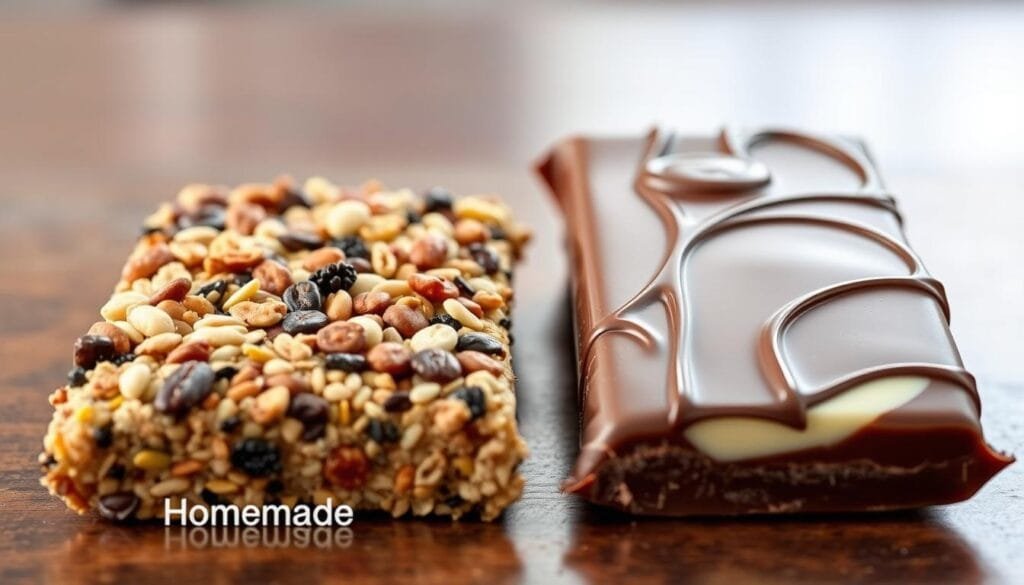
When deciding between traditional and plant-based energy bars, consider your dietary needs, goals, and values. Understanding the differences helps you choose the best option for your active lifestyle and well-being.
How to Choose the Right Plant-based Bar for Your Activity
When it comes to sports nutrition, finding the right fuel is key. The right plant-based bar can be your perfect companion. It gives you the energy and nutrients your body needs for your specific activity. Whether you’re an endurance athlete or focused on muscle recovery, knowing your nutritional needs is important.
For endurance activities like running, cycling, or swimming, look for bars with a lot of carbohydrates. These bars should also have added electrolytes like sodium and potassium. This helps keep your body’s fluid balance and prevents cramping. Bars with a 4:1 carbohydrate-to-protein ratio are best for replenishing glycogen stores and supporting muscle function.
If your goal is muscle recovery, look for bars with more protein. Organic, plant-based protein sources like nuts, seeds, and legumes are great. Aim for bars with at least 10-20 grams of protein per serving.
Always check the ingredient list, no matter your activity. Choose bars made with whole, natural ingredients without artificial additives or refined sugars. The right plant-based bar should nourish your body with a balanced mix of complex carbohydrates, healthy fats, and high-quality protein.
| Activity | Ideal Nutritional Profile | Recommended Bars |
|---|---|---|
| Endurance (e.g., running, cycling, swimming) | Higher carbohydrates (40-60g), added electrolytes, 4:1 carb-to-protein ratio | Jelly Bar 4Energy, Half Nrgy Unit Juice Bar Nduranz |
| Muscle Recovery | Higher protein (10-20g), plant-based protein sources | ALOHA Organic Protein Bars, Protein Bar Sample Pack |
Remember, the perfect plant-based bar for you is the one that meets your specific nutritional needs and activity level. Try different options and see how your body responds. This will help you find the personalized fueling that helps you perform at your best.
Optimal Timing: When to Consume Energy Bars
Timing is key when it comes to energy bars. They can help you power through workouts, keep energy up during exercise, or aid in recovery after. Knowing when to eat them can make a big difference.
Pre-workout Fueling
Eating an energy bar 30-60 minutes before working out gives your body the energy it needs. Look for a bar with 30-50 grams of carbs to fuel your muscles.
During Exercise Consumption
If you’re doing something for 75 minutes or more, eat small energy bars every 45-60 minutes. This keeps your energy up and helps you perform better, with up to 90 grams of carbs an hour.
Post-workout Recovery
Eating an energy bar within 30 minutes after working out helps your muscles recover and replenishes energy. Choose a bar with carbs and proteins in a 4:1 ratio to start recovery.
The best time to eat energy bars depends on your workout’s intensity and length. Adjust how much you eat to match your needs for optimal fueling.
| Timing | Recommended Energy Bar Intake | Benefits |
|---|---|---|
| Pre-workout | 30-60 minutes before, 30-50 grams of carbohydrates | Provides readily available energy for your workout |
| During Exercise | Every 45-60 minutes, up to 90 grams of carbohydrates per hour | Helps maintain energy levels and optimize performance |
| Post-workout | Within 30 minutes, balanced carbohydrates and proteins (4:1 ratio) | Supports muscle recovery and replenishes energy stores |
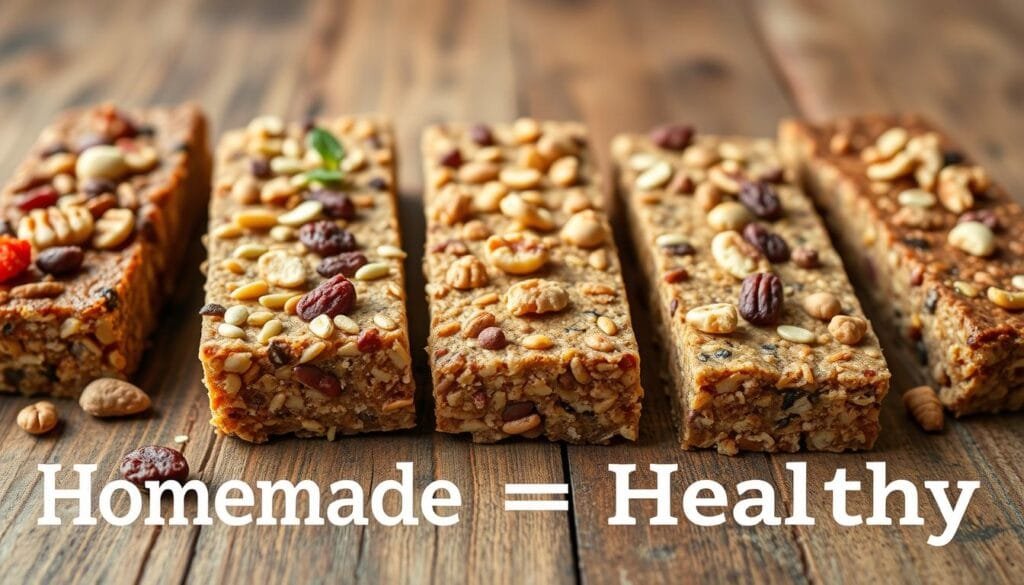
By matching your energy bar intake with your workout plan, you fuel your active lifestyle. This maximizes the benefits of your training.
Understanding Macronutrient Ratios in Energy Bars
When you’re active, the right mix in your energy bars is key. The best mix is usually 4:1. This means carbohydrates give you long-lasting energy, and protein helps your muscles recover. This mix ensures your body gets what it needs to perform well.
Adding healthy fats from nuts and seeds boosts the bar’s nutrient density. These fats give extra energy and help your body absorb important vitamins and minerals.
Knowing about these ratios helps you pick the right energy bars. Whether you’re an athlete or just active, focusing on the right mix ensures you get the balanced nutrition your body wants.
| Macronutrient | Recommended Ratio for Athletes | Recommended Daily Intake |
|---|---|---|
| Carbohydrates | 60% of total calories | 225-325 grams (for a 2,000 calorie diet) |
| Protein | 20-25% of total calories | Consume 20-30 grams within 30-60 minutes post-workout |
| Fats | 20% of total calories | Less than 10% from saturated fats |
By understanding these ratios, you can choose energy bars that fuel your body right. This is true whether you’re doing a tough workout or just enjoying an active day.
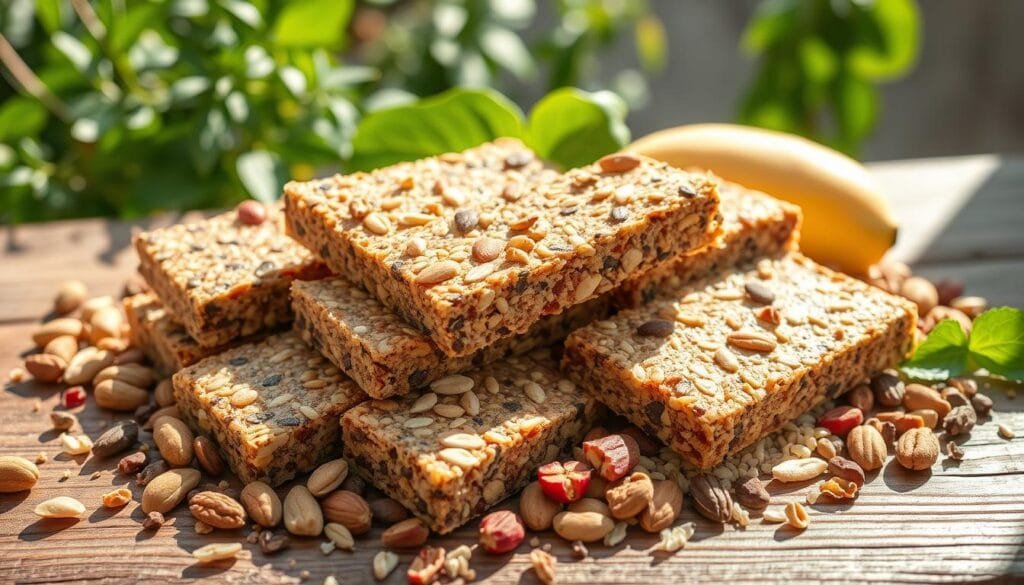
Plant-based Protein Sources in Modern Energy Bars
Modern energy bars are now using plant-based proteins to meet the demand for healthier snacks. Pea protein, hemp protein, and rice protein are popular for their benefits to athletes and fitness lovers. They offer a complete amino acid profile, essential for muscle recovery and growth.
Pea protein is known for being easy to digest and low in allergens. It’s a favorite among those looking for a good protein source. Hemp protein not only has all the amino acids but also omega-3 fatty acids and other nutrients. Rice protein is gentle on the stomach and hypoallergenic, making it a great choice for many.
By mixing these plant-based proteins, energy bar makers can offer a full amino acid profile. This supports athletes in their performance and recovery. It shows how natural, sustainable, and ethical food choices are becoming more popular.
| Protein Source | Key Benefits | Example Brands |
|---|---|---|
| Pea Protein | Complete amino acid profile, easy digestibility, low allergen | ALOHA, Rise Bar, No Cow |
| Hemp Protein | Complete amino acids, omega-3 fatty acids, nutrient-rich | Evo Hemp, Raw Rev Glo |
| Rice Protein | Gentle on the stomach, hypoallergenic | Good! Snacks, Larabar |
The plant-based food industry is growing, and so is the variety of proteins in energy bars. This meets the needs of health-conscious consumers who want natural and sustainable options.
The Role of Electrolytes and Minerals in Energy Bars
Electrolytes and minerals are key in energy bars. They help with hydration and improve physical performance. Nutrients like magnesium, potassium, and calcium are important for muscles and overall health.
Essential Minerals for Performance
Energy bars with lots of minerals are great for athletes. Pink Himalayan salt adds trace minerals. These help with hydration, prevent cramps, and boost performance.
- Magnesium helps with muscle and nerve function, and energy.
- Potassium keeps fluid balance and muscle contractions right.
- Calcium is key for strong bones and muscles.
Hydration and Electrolyte Balance
Good hydration and electrolyte balance are vital for athletes. Energy bars with electrolytes like sodium, potassium, and chloride help replace lost salts. This supports hydration support and performance enhancement.
| Electrolyte | Key Functions | Food Sources |
|---|---|---|
| Sodium | Fluid balance, muscle and nerve function | Himalayan pink salt, leafy greens |
| Potassium | Muscle contraction, heart function | Bananas, sweet potatoes, avocados |
| Magnesium | Nerve and muscle function, energy production | Pumpkin seeds, spinach, almonds |
Energy bars with mineral-rich foods and balanced electrolytes offer great nutrient absorption. They help active people perform at their best.
Storage and Shelf Life: Maintaining Bar Quality
Keeping my plant-based energy bars fresh is very important. Most bars stay good for up to 12 months if stored right. It’s key to keep them away from extreme temperatures and sunlight.
Some bars might get softer in warm places because of ingredients like chocolate. Always check the packaging for storage tips. This helps keep your bars fresh and ready for your active life.
Following the right storage tips keeps my bars in top shape. This way, they give me the energy I need for workouts or after intense sessions.
